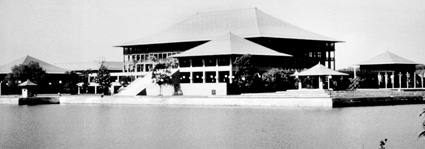"Members
having
pursuant to Proclamation of March 26, 1982 assembled in the Chamber of Parliament at Sri Jayewardenepura at 10.15 a.m," is how the Hansard recorded the Ceremonial Opening of the second session of the First Parliament of The Democratic Socialist Republic of Sri Lanka on Thursday April 29, 1982.
It was a significant day in the history of Parliament in Sri Lanka. The day marked the opening of the new Parliamentary Complex at
Sri Jayewardenepura Kotte by President
J. R. Jayewardene.
 |
| Parliamentary Complex at
Sri Jayewardenepura Kotte |
The shifting of Parliament to the new administrative capital, Kotte also marked the end of the sittings of Parliament at what was known as the State Council building at Galle Face. It had existed from 1930 onwards with members of the Legislative Council (1930 – 31), the State Council (1931 – 47), the House of Representatives (1947–72), the National State Assembly (1972 – 78) and Parliament (1978 – 82) conducting the meetings there.
The decision to build a new Parliament was made as early as April 1967, when engineers expressed the view that alterations of extensions to the Galle Face building to accommodate 200 members was not possible. (Originally the Chamber had been built to sit only 50 members). However, it was only in August 1970, at a meeting of the leaders of parties presided over by Speaker Stanley Tillekeratne that it was suggested that
Sri Lanka's renowned
architect Geoffrey Bawa of Messrs. Edward, Reid & Begg Architects prepare the preliminary plans.
In June 1972, an allocation of Rs. 2.2 million was passed by the Cabinet for Stage 1 of the project.
It was after the July 1977 general election that the project really got going and it was decided to
locate a site in
Sri Jayewardenepura Kotte and an island in the
historic Diyawanna Oya was selected. Mr. Bawa was accepted as the
architect and Japan's Mitsui Ltd., were chosen as the builders. The building was completed in an extremely short period of around three years.
In his address to Parliament at the
ceremonial opening, President Jayewardene traced the history of
representative government of Sri Lanka and also the history of the kingdom of Kotte. Referring to the new Complex he said: "We see around us in these new buildings features that
represent the culture and heritage of the past and embody our hopes and
aspirations for the future. We commence here a new era of Parliamentary Democracy in a Chamber worthy of an elected and sovereign assembly. "
Stating that the Chamber is perhaps unparalleled in beauty anywhere in the world, Prime Minister Ranasinghe Premadasa stressed that the principal business of the Members of Parliament will be the enhancement of the
welfare of the people.
"The body of men on whom the ordinary people rely to safeguard their rights and liberties are the Members of this august Assembly. The House is the
repository of the rights and liberties of a free people. Here reside both the pulse and heart-beat of the nation. The sacred trust that has been placed in our hands is to defend and guard the rights and
liberties of our people."
The Leader of the Opposition,
A. Amirthalingam and Member for Medawachchiya, Maitripala Senanayake (on behalf of the Sri Lanka Freedom Party), MP for Kalawana, Sarath Muttetuwegama and Minister of State and MP for Kotte, Anandatissa de Alwis also spoke.
Built on marshy land
From 'Geoffrey Bawa'
by Brian Brace Taylor:
The site chosen for the new Parliament building was a marsh around a small island. The marsh was dredged to form a large man-made lake with a wide shore, later to be thickly wooded with indigenous trees. The approach is across a great causeway and forecourt to the bronze doors in the entrance arcade; then up the ceremonial stairs leading through the
silver doors to the central core of power – the Chamber – within the main pavilion.
The main pavilion, with its balconies and galleries, rises three
stories above the two
levels of tiered terraces within which are the administrative offices and committee rooms. Other pavilions of
varying sizes and
functions form part of the main composition of roofs and terraces.
The huge copper roofs of the pavilions, large and small, supported by the traditional patterns of timber and stone columns, have an echo of the monastic and royal buildings of the past… |

